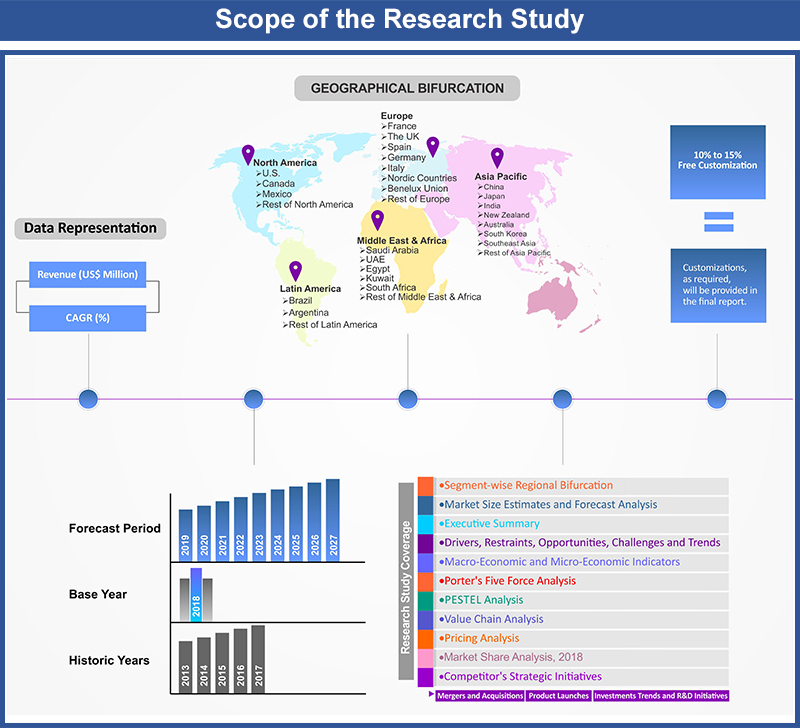HVAC Application Sensor Market by Product Type (Pressure Sensors, Temperature Sensors, Humidity Sensors, CO2/VOC Sensors, Internet of Things (IoT) Tools, and Others); by Regional outlook (U.S., Rest of North America, France, UK, Germany, Spain, Italy, Rest of Europe, China, Japan, India, Southeast Asia, Rest of Asia Pacific, GCC Countries, Southern Africa, Rest of MEA, Brazil, Rest of Latin America) – Global Insights, Growth, Size, Comparative Analysis, Trends and Forecast, 2018 - 2026
Industry Trends
Sensors for heating ventilation and air conditioning (HVAC) systems play an important role in automated buildings and homes. It maintains the room temperature by automatically comparing the state of the room or the building temperature to the ideal or desired temperature that has been input into the system and making adjustments accordingly.
Global HVAC application sensor market, in terms of revenue, which was estimated at US$ 2400.5 million in 2017, is expected to reach US$ 3383.9 million in 2021.
Global HVAC Application Sensor Market, By Product Type, 2017 & 2021 (US$ Million)
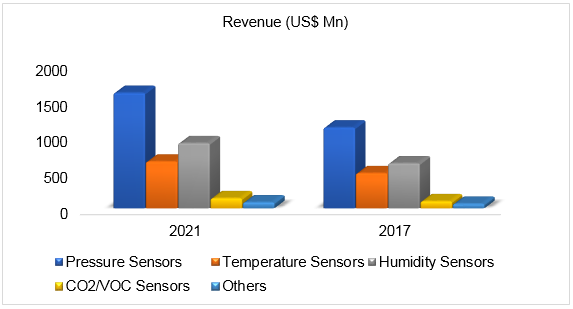
The high number of components in large, commercial buildings makes it difficult for the operation staff to keep a track of all the equipment and system conditions. The absence of automated monitoring and fault detection with the help of sensors in HVAC applications can degrade the performance of these systems. Furthermore, the rising energy consumption has led to the adoption of sensors in automated buildings. The use of smart sensors and control systems has resulted in the reduction in energy consumption. This has driven the adoption of HVAC application sensors market in commercial, industrial and residential sectors. However, lack of awareness regarding the benefits of usage of HVAC applications sensor is hampering the growth of the market.
HVAC Application Sensor Market, By Product Type
Amongst the product types, pressure sensors held the largest market share in terms of revenue. Pressure sensors measure pressure and air flow throughout the system and help in effective air distribution. Hence, they are critical components in ensuring the energy consumption efficiency of the HVAC applications. The integration of HVAC application sensors with pressure technology, ensures that the systems are running at optimum level, thereby improving the building maintenance.
HVAC Application Sensor Market, By Region
On the basis of geography, Asia Pacific region occupies the largest market in terms of consumption and demand for HVAC application sensor market globally. The need for energy efficient solutions has intensified with the growing energy consumption levels in this region. The rapid industrial developments in Asia Pacific has aggravated the issue of high energy consumption and the resultant environmental damages caused. Sensors in HVAC applications can reduce energy consumption and costs. This is has driven the market in Asia Pacific.
Competitive Landscape
The report provides both, qualitative and quantitative research of the market, as well as integrates worthy insights into the rational scenario and favored development methods adopted by the key contenders. The HVAC application sensor market report also offers extensive research on the key players in this market and detailed insights on the competitiveness of these players. The key business strategies such as mergers & acquisitions (M&A), affiliations, collaborations, and contracts adopted by the major players are also recognized and analyzed in the report. For each company, the report recognizes their corporate headquarter, competitors, product/service type, application and specification, pricing, and gross margin.
Some of the primary market participants are Rockwell Automation, Inc., Schneider Electric, Siemens, Sensata Technologies, Inc., Johnson Controls, Honeywell International Inc., CST, NXP Semiconductors, Vaisala, TE Connectivity Corporation (AST), EPCOS AG, Sensirion AG, Setra Systems, Inc., E + E ELEKTRONIK GES.M.B.H, KROHNE, First Sensor AG, U.S. Sensor Corp, Pyromation, Minco Products, Inc., Delta Controls, Inc., Novar, Melexis, USTSensor Technic Co., Ltd. amongst others.
Global HVAC Application Sensor Industry Background
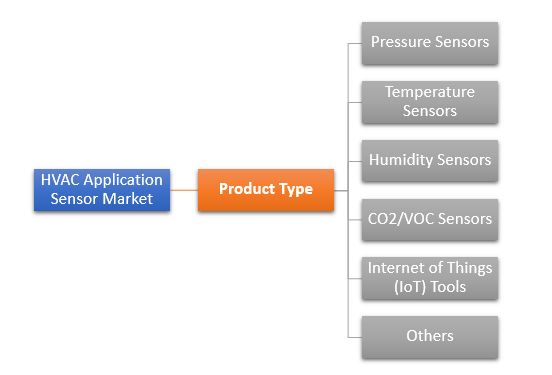
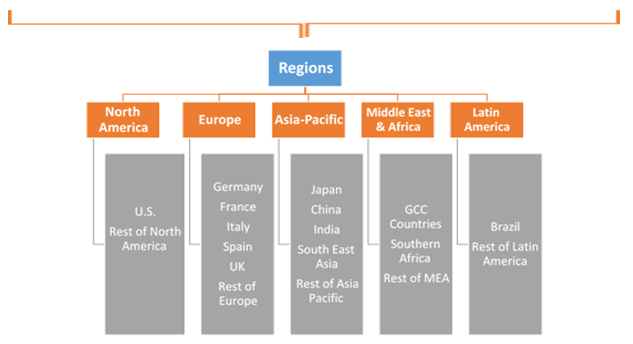
Table of Contents
1. Introduction
1.1. Market Scope
1.2. Market Segmentation
1.3. Methodology
1.4. Assumptions
2. HVAC Application Sensor Market Snapshot
3. Executive Summary: HVAC Application Sensor Market
4. Qualitative Analysis: HVAC Application Sensor Market
4.1. Introduction
4.1.1. Product Definition
4.1.2. Industry Development
4.2. Market Dynamics
4.2.1. Drivers
4.2.2. Restraints
4.2.3. Opportunities
4.3. Trends in Market
5. Global HVAC Application Sensor Market Analysis and Forecasts,
2018 – 2026
5.1. Overview
5.1.1. Global Market Revenue (US$ Mn) and Forecasts
5.2. Global HVAC Application Sensor Market Revenue (US$ Mn) and
Forecasts, By Product Type
5.2.1. Pressure Sensors
5.2.1.1. Definition
5.2.1.2. Market Penetration
5.2.1.3. Market Revenue Expected to Increase by 2026
5.2.1.4. Compound Annual Growth Rate (CAGR)
5.2.2. Temperature Sensors
5.2.2.1. Definition
5.2.2.2. Market Penetration
5.2.2.3. Market Revenue Expected to Increase by 2026
5.2.2.4. Compound Annual Growth Rate (CAGR)
5.2.3. Humidity Sensors
5.2.3.1. Definition
5.2.3.2. Market Penetration
5.2.3.3. Market Revenue Expected to Increase by 2026
5.2.3.4. Compound Annual Growth Rate (CAGR)
5.2.4. CO2/VOC Sensors
5.2.4.1. Definition
5.2.4.2. Market Penetration
5.2.4.3. Market Revenue Expected to Increase by 2026
5.2.4.4. Compound Annual Growth Rate (CAGR)
5.2.5. Internet of Things (IoT) Tools
5.2.5.1. Definition
5.2.5.2. Market Penetration
5.2.5.3. Market Revenue Expected to Increase by 2026
5.2.5.4. Compound Annual Growth Rate (CAGR)
5.2.6. Others
5.2.6.1. Definition
5.2.6.2. Market Penetration
5.2.6.3. Market Revenue Expected to Increase by 2026
5.2.6.4. Compound Annual Growth Rate (CAGR)
5.3. Key Segment for Channeling Investments
5.3.1. By Product Type
6. North America HVAC Application Sensor Market Analysis and
Forecasts, 2018 – 2026
6.1. Overview
6.1.1. North America Market Revenue (US$ Mn)
6.2. North America HVAC Application Sensor Market Revenue (US$ Mn)
and Forecasts, By Product Type
6.2.1. Pressure Sensors
6.2.2. Temperature Sensors
6.2.3. Humidity Sensors
6.2.4. CO2/VOC Sensors
6.2.5. Internet of Things (IoT) Tools
6.2.6. Others
6.3. North America HVAC Application Sensor Market Revenue (US$ Mn)
and Forecasts, By Country
6.3.1. U.S.
6.3.1.1. U.S. HVAC Application Sensor Market Revenue (US$ Mn) and
Forecasts, By Product Type
6.3.1.1.1. Pressure Sensors
6.3.1.1.2. Temperature Sensors
6.3.1.1.3. Humidity Sensors
6.3.1.1.4. CO2/VOC Sensors
6.3.1.1.5. Internet of Things (IoT) Tools
6.3.1.1.6. Others
6.3.2. Rest of North America
6.3.2.1. Rest of North America HVAC Application Sensor Market Revenue
(US$ Mn) and Forecasts, By Product Type
6.3.2.1.1. Pressure Sensors
6.3.2.1.2. Temperature Sensors
6.3.2.1.3. Humidity Sensors
6.3.2.1.4. CO2/VOC Sensors
6.3.2.1.5. Internet of Things (IoT) Tools
6.3.2.1.6. Others
6.4. Key Segment for Channeling Investments
6.4.1. By Country
6.4.2. By Product Type
7. Europe HVAC Application Sensor Market Analysis and Forecasts,
2018 – 2026
7.1. Overview
7.1.1. Europe Market Revenue (US$ Mn)
7.2. Europe HVAC Application Sensor Market Revenue (US$ Mn) and
Forecasts, By Product Type
7.2.1. Pressure Sensors
7.2.2. Temperature Sensors
7.2.3. Humidity Sensors
7.2.4. CO2/VOC Sensors
7.2.5. Internet of Things (IoT) Tools
7.2.6. Others
7.3. Europe HVAC Application Sensor Market Revenue (US$ Mn) and
Forecasts, By Country
7.3.1. France
7.3.1.1. France HVAC Application Sensor Market Revenue (US$ Mn) and
Forecasts, By Product Type
7.3.1.1.1. Pressure Sensors
7.3.1.1.2. Temperature Sensors
7.3.1.1.3. Humidity Sensors
7.3.1.1.4. CO2/VOC Sensors
7.3.1.1.5. Internet of Things (IoT) Tools
7.3.1.1.6. Others
7.3.2. The UK
7.3.2.1. The UK HVAC Application Sensor Market Revenue (US$ Mn) and
Forecasts, By Product Type
7.3.2.1.1. Pressure Sensors
7.3.2.1.2. Temperature Sensors
7.3.2.1.3. Humidity Sensors
7.3.2.1.4. CO2/VOC Sensors
7.3.2.1.5. Internet of Things (IoT) Tools
7.3.2.1.6. Others
7.3.3. Spain
7.3.3.1. Spain HVAC Application Sensor Market Revenue (US$ Mn) and
Forecasts, By Product Type
7.3.3.1.1. Pressure Sensors
7.3.3.1.2. Temperature Sensors
7.3.3.1.3. Humidity Sensors
7.3.3.1.4. CO2/VOC Sensors
7.3.3.1.5. Internet of Things (IoT) Tools
7.3.3.1.6. Others
7.3.4. Germany
7.3.4.1. Germany HVAC Application Sensor Market Revenue (US$ Mn) and
Forecasts, By Product Type
7.3.4.1.1. Pressure Sensors
7.3.4.1.2. Temperature Sensors
7.3.4.1.3. Humidity Sensors
7.3.4.1.4. CO2/VOC Sensors
7.3.4.1.5. Internet of Things (IoT) Tools
7.3.4.1.6. Others
7.3.5. Italy
7.3.5.1. Italy HVAC Application Sensor Market Revenue (US$ Mn) and
Forecasts, By Product Type
7.3.5.1.1. Pressure Sensors
7.3.5.1.2. Temperature Sensors
7.3.5.1.3. Humidity Sensors
7.3.5.1.4. CO2/VOC Sensors
7.3.5.1.5. Internet of Things (IoT) Tools
7.3.5.1.6. Others
7.3.6. Rest of Europe
7.3.6.1. Rest of Europe HVAC Application Sensor Market Revenue (US$ Mn)
and Forecasts, By Product Type
7.3.6.1.1. Pressure Sensors
7.3.6.1.2. Temperature Sensors
7.3.6.1.3. Humidity Sensors
7.3.6.1.4. CO2/VOC Sensors
7.3.6.1.5. Internet of Things (IoT) Tools
7.3.6.1.6. Others
7.4. Key Segment for Channeling Investments
7.4.1. By Country
7.4.2. By Product Type
8. Asia Pacific HVAC Application Sensor Market Analysis and
Forecasts, 2018 – 2026
8.1. Overview
8.1.1. Asia Pacific Market Revenue (US$ Mn)
8.2. Asia Pacific HVAC Application Sensor Market Revenue (US$ Mn)
and Forecasts, By Product Type
8.2.1. Pressure Sensors
8.2.2. Temperature Sensors
8.2.3. Humidity Sensors
8.2.4. CO2/VOC Sensors
8.2.5. Internet of Things (IoT) Tools
8.2.6. Others
8.3. Asia Pacific HVAC Application Sensor Market Revenue (US$ Mn)
and Forecasts, By Country
8.3.1. China
8.3.1.1. China HVAC Application Sensor Market Revenue (US$ Mn) and
Forecasts, By Product Type
8.3.1.1.1. Pressure Sensors
8.3.1.1.2. Temperature Sensors
8.3.1.1.3. Humidity Sensors
8.3.1.1.4. CO2/VOC Sensors
8.3.1.1.5. Internet of Things (IoT) Tools
8.3.1.1.6. Others
8.3.2. Japan
8.3.2.1. Japan HVAC Application Sensor Market Revenue (US$ Mn) and
Forecasts, By Product Type
8.3.2.1.1. Pressure Sensors
8.3.2.1.2. Temperature Sensors
8.3.2.1.3. Humidity Sensors
8.3.2.1.4. CO2/VOC Sensors
8.3.2.1.5. Internet of Things (IoT) Tools
8.3.2.1.6.
Others
8.3.3. India
8.3.3.1. India HVAC Application Sensor Market Revenue (US$ Mn) and
Forecasts, By Product Type
8.3.3.1.1. Pressure Sensors
8.3.3.1.2. Temperature Sensors
8.3.3.1.3. Humidity Sensors
8.3.3.1.4. CO2/VOC Sensors
8.3.3.1.5. Internet of Things (IoT) Tools
8.3.3.1.6. Others
8.3.4. Southeast Asia
8.3.4.1. Southeast Asia HVAC Application Sensor Market Revenue (US$ Mn)
and Forecasts, By Product Type
8.3.4.1.1. Pressure Sensors
8.3.4.1.2. Temperature Sensors
8.3.4.1.3. Humidity Sensors
8.3.4.1.4. CO2/VOC Sensors
8.3.4.1.5. Internet of Things (IoT) Tools
8.3.4.1.6. Others
8.3.5. Rest of Asia Pacific
8.3.5.1. Rest of Asia Pacific HVAC Application Sensor Market Revenue
(US$ Mn) and Forecasts, By Product Type
8.3.5.1.1. Pressure Sensors
8.3.5.1.2. Temperature Sensors
8.3.5.1.3. Humidity Sensors
8.3.5.1.4. CO2/VOC Sensors
8.3.5.1.5. Internet of Things (IoT) Tools
8.3.5.1.6. Others
8.4. Key Segment for Channeling Investments
8.4.1. By Country
8.4.2. By Product Type
9. Middle East and Africa HVAC Application Sensor Market
Analysis and Forecasts, 2018 – 2026
9.1. Overview
9.1.1. Middle East and Africa Market Revenue (US$ Mn)
9.2. Middle East and Africa HVAC Application Sensor Market Revenue
(US$ Mn) and Forecasts, By Product Type
9.2.1. Pressure Sensors
9.2.2. Temperature Sensors
9.2.3. Humidity Sensors
9.2.4. CO2/VOC Sensors
9.2.5. Internet of Things (IoT) Tools
9.2.6. Others
9.3. Middle East and Africa HVAC Application Sensor Market Revenue (US$
Mn) and Forecasts, By Country
9.3.1. GCC Countries
9.3.1.1. GCC Countries HVAC Application Sensor Market Revenue (US$ Mn)
and Forecasts, By Product Type
9.3.1.1.1. Pressure Sensors
9.3.1.1.2. Temperature Sensors
9.3.1.1.3. Humidity Sensors
9.3.1.1.4. CO2/VOC Sensors
9.3.1.1.5. Internet of Things (IoT) Tools
9.3.1.1.6. Others
9.3.2. Southern Africa
9.3.2.1. Southern Africa HVAC Application Sensor Market Revenue (US$
Mn) and Forecasts, By Product Type
9.3.2.1.1. Pressure Sensors
9.3.2.1.2. Temperature Sensors
9.3.2.1.3. Humidity Sensors
9.3.2.1.4. CO2/VOC Sensors
9.3.2.1.5. Internet of Things (IoT) Tools
9.3.2.1.6. Others
9.3.3. Rest of MEA
9.3.3.1. Rest of MEA HVAC Application Sensor Market Revenue (US$ Mn)
and Forecasts, By Product Type
9.3.3.1.1. Pressure Sensors
9.3.3.1.2. Temperature Sensors
9.3.3.1.3. Humidity Sensors
9.3.3.1.4. CO2/VOC Sensors
9.3.3.1.5. Internet of Things (IoT) Tools
9.3.3.1.6. Others
9.4. Key Segment for Channeling Investments
9.4.1. By Country
9.4.2.
By Product Type
10. Latin America HVAC Application Sensor Market Analysis and
Forecasts, 2018 – 2026
10.1. Overview
10.1.1. Latin America Market Revenue (US$ Mn)
10.2. Latin America HVAC Application Sensor Market Revenue (US$ Mn)
and Forecasts, By Product Type
10.2.1. Pressure Sensors
10.2.2. Temperature Sensors
10.2.3. Humidity Sensors
10.2.4. CO2/VOC Sensors
10.2.5. Internet of Things (IoT) Tools
10.2.6. Others
10.3. Latin America HVAC Application Sensor Market Revenue (US$ Mn)
and Forecasts, By Country
10.3.1. Brazil
10.3.1.1. Brazil HVAC Application Sensor Market Revenue (US$ Mn) and
Forecasts, By Product Type
10.3.1.1.1. Pressure Sensors
10.3.1.1.2. Temperature Sensors
10.3.1.1.3. Humidity Sensors
10.3.1.1.4. CO2/VOC Sensors
10.3.1.1.5. Internet of Things (IoT) Tools
10.3.1.1.6. Others
10.3.2. Rest of Latin America
10.3.2.1. Rest of Latin America HVAC Application Sensor Market Revenue
(US$ Mn) and Forecasts, By Product Type
10.3.2.1.1. Pressure Sensors
10.3.2.1.2. Temperature Sensors
10.3.2.1.3. Humidity Sensors
10.3.2.1.4. CO2/VOC Sensors
10.3.2.1.5. Internet of Things (IoT) Tools
10.3.2.1.6. Others
10.4. Key Segment for Channeling Investments
10.4.1. By Country
10.4.2. By Product Type
11. Competitive Benchmarking
11.1. Player Positioning Analysis
11.2. Global Presence and Growth Strategies
12. Player Profiles
12.1. CST
12.1.1. Company Details
12.1.2. Company Overview
12.1.3. Product Offerings
12.1.4. Key Developments
12.1.5. Financial Analysis
12.1.6. SWOT Analysis
12.1.7. Business Strategies
12.2. Delta Controls, Inc.
12.2.1. Company Details
12.2.2. Company Overview
12.2.3. Product Offerings
12.2.4. Key Developments
12.2.5. Financial Analysis
12.2.6. SWOT Analysis
12.2.7. Business Strategies
12.3. E + E ELEKTRONIK GES.M.B.H
12.3.1. Company Details
12.3.2. Company Overview
12.3.3. Product Offerings
12.3.4. Key Developments
12.3.5. Financial Analysis
12.3.6. SWOT Analysis
12.3.7. Business Strategies
12.4. EPCOS AG
12.4.1. Company Details
12.4.2. Company Overview
12.4.3. Product Offerings
12.4.4. Key Developments
12.4.5. Financial Analysis
12.4.6. SWOT Analysis
12.4.7. Business Strategies
12.5. First Sensor AG
12.5.1. Company Details
12.5.2. Company Overview
12.5.3. Product Offerings
12.5.4. Key Developments
12.5.5. Financial Analysis
12.5.6. SWOT Analysis
12.5.7. Business Strategies
12.6. Honeywell International Inc.
12.6.1. Company Details
12.6.2. Company Overview
12.6.3. Product Offerings
12.6.4. Key Developments
12.6.5. Financial Analysis
12.6.6. SWOT Analysis
12.6.7. Business Strategies
12.7. Johnson Controls
12.7.1. Company Details
12.7.2. Company Overview
12.7.3. Product Offerings
12.7.4. Key Developments
12.7.5. Financial Analysis
12.7.6. SWOT Analysis
12.7.7. Business Strategies
12.8. KROHNE
12.8.1. Company Details
12.8.2. Company Overview
12.8.3. Product Offerings
12.8.4. Key Developments
12.8.5. Financial Analysis
12.8.6. SWOT Analysis
12.8.7. Business Strategies
12.9. Melexis
12.9.1. Company Details
12.9.2. Company Overview
12.9.3. Product Offerings
12.9.4. Key Developments
12.9.5. Financial Analysis
12.9.6. SWOT Analysis
12.9.7. Business Strategies
12.10. Minco Products, Inc.
12.10.1. Company Details
12.10.2. Company Overview
12.10.3.
Product Offerings
12.10.4.
Key Developments
12.10.5.
Financial Analysis
12.10.6.
SWOT Analysis
12.10.7. Business Strategies
12.11. Novar
12.11.1.
Company Details
12.11.2.
Company Overview
12.11.3.
Product Offerings
12.11.4.
Key Developments
12.11.5.
Financial Analysis
12.11.6.
SWOT Analysis
12.11.7. Business Strategies
12.12. NXP Semiconductors
12.12.1.
Company Details
12.12.2.
Company Overview
12.12.3.
Product Offerings
12.12.4.
Key Developments
12.12.5.
Financial Analysis
12.12.6.
SWOT Analysis
12.12.7. Business Strategies
12.13. Pyromation
12.13.1.
Company Details
12.13.2.
Company Overview
12.13.3.
Product Offerings
12.13.4.
Key Developments
12.13.5.
Financial Analysis
12.13.6.
SWOT Analysis
12.13.7. Business Strategies
12.14. Rockwell Automation, Inc.
12.14.1.
Company Details
12.14.2.
Company Overview
12.14.3.
Product Offerings
12.14.4.
Key Developments
12.14.5.
Financial Analysis
12.14.6. SWOT Analysis
12.14.7. Business Strategies
12.15. Schneider Electric
12.15.1.
Company Details
12.15.2.
Company Overview
12.15.3.
Product Offerings
12.15.4.
Key Developments
12.15.5.
Financial Analysis
12.15.6.
SWOT Analysis
12.15.7. Business Strategies
12.16. Sensata Technologies, Inc.
12.16.1.
Company Details
12.16.2.
Company Overview
12.16.3.
Product Offerings
12.16.4.
Key Developments
12.16.5.
Financial Analysis
12.16.6.
SWOT Analysis
12.16.7. Business Strategies
12.17. Sensirion AG
12.17.1.
Company Details
12.17.2.
Company Overview
12.17.3.
Product Offerings
12.17.4.
Key Developments
12.17.5.
Financial Analysis
12.17.6.
SWOT Analysis
12.17.7. Business Strategies
12.18. Setra Systems, Inc.
12.18.1.
Company Details
12.18.2.
Company Overview
12.18.3.
Product Offerings
12.18.4.
Key Developments
12.18.5.
Financial Analysis
12.18.6.
SWOT Analysis
12.18.7. Business Strategies
12.19. Siemens
12.19.1.
Company Details
12.19.2. Company Overview
12.19.3.
Product Offerings
12.19.4.
Key Developments
12.19.5.
Financial Analysis
12.19.6.
SWOT Analysis
12.19.7. Business Strategies
12.20. TE Connectivity Corporation (AST)
12.20.1.
Company Details
12.20.2.
Company Overview
12.20.3.
Product Offerings
12.20.4.
Key Developments
12.20.5.
Financial Analysis
12.20.6.
SWOT Analysis
12.20.7. Business Strategies
12.21. U.S. Sensor Corp
12.21.1.
Company Details
12.21.2.
Company Overview
12.21.3.
Product Offerings
12.21.4.
Key Developments
12.21.5.
Financial Analysis
12.21.6. SWOT Analysis
12.21.7. Business Strategies
12.22. USTSensor Technic Co., Ltd.
12.22.1.
Company Details
12.22.2.
Company Overview
12.22.3.
Product Offerings
12.22.4.
Key Developments
12.22.5.
Financial Analysis
12.22.6.
SWOT Analysis
12.22.7. Business Strategies
12.23. Vaisala
12.23.1.
Company Details
12.23.2.
Company Overview
12.23.3.
Product Offerings
12.23.4.
Key Developments
12.23.5.
Financial Analysis
12.23.6. SWOT Analysis
12.23.7. Business Strategies
At Absolute Markets Insights, we are engaged in building both global as well as country specific reports. As a result, the approach taken for deriving the estimation and forecast for a specific country is a bit unique and different in comparison to the global research studies. In this case, we not only study the concerned market factors & trends prevailing in a particular country (from secondary research) but we also tend to calculate the actual market size & forecast from the revenue generated from the market participants involved in manufacturing or distributing the any concerned product. These companies can also be service providers. For analyzing any country specifically, we do consider the growth factors prevailing under the states/cities/county for the same. For instance, if we are analyzing an industry specific to United States, we primarily need to study about the states present under the same(where the product/service has the highest growth). Similar analysis will be followed by other countries. Our scope of the report changes with different markets.
Our research study is mainly implement through a mix of both secondary and primary research. Various sources such as industry magazines, trade journals, and government websites and trade associations are reviewed for gathering precise data. Primary interviews are conducted to validate the market size derived from secondary research. Industry experts, major manufacturers and distributors are contacted for further validation purpose on the current market penetration and growth trends.
Prominent participants in our primary research process include:
- Key Opinion Leaders namely the CEOs, CSOs, VPs, purchasing managers, amongst others
- Research and development participants, distributors/suppliers and subject matter experts
Secondary Research includes data extracted from paid data sources:
- Reuters
- Factiva
- Bloomberg
- One Source
- Hoovers
Research Methodology
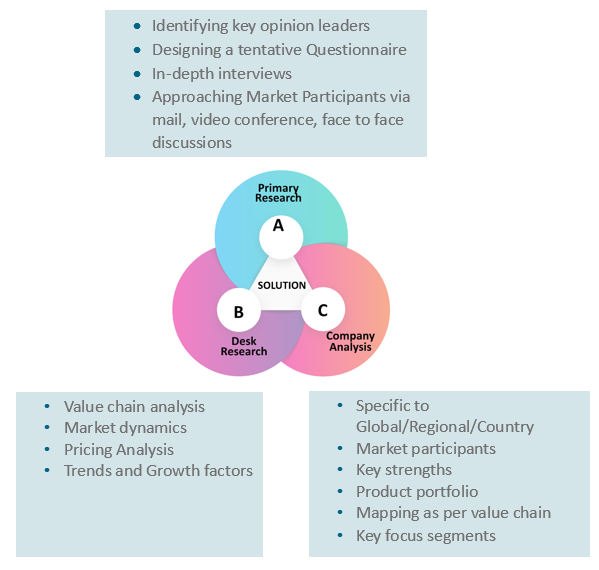
Key Inclusions
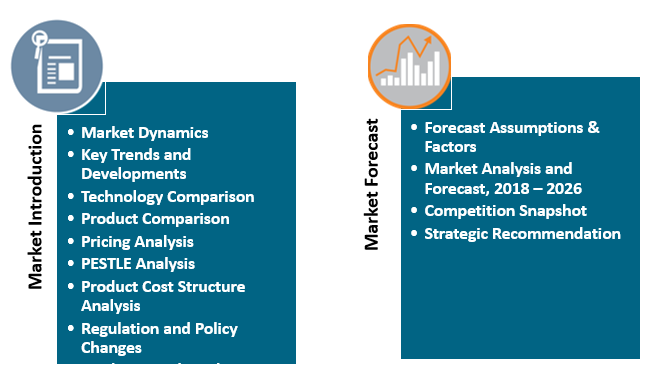
Reach to us
Call us on
+91-74002-42424
Drop us an email at
sales@absolutemarketsinsights.com
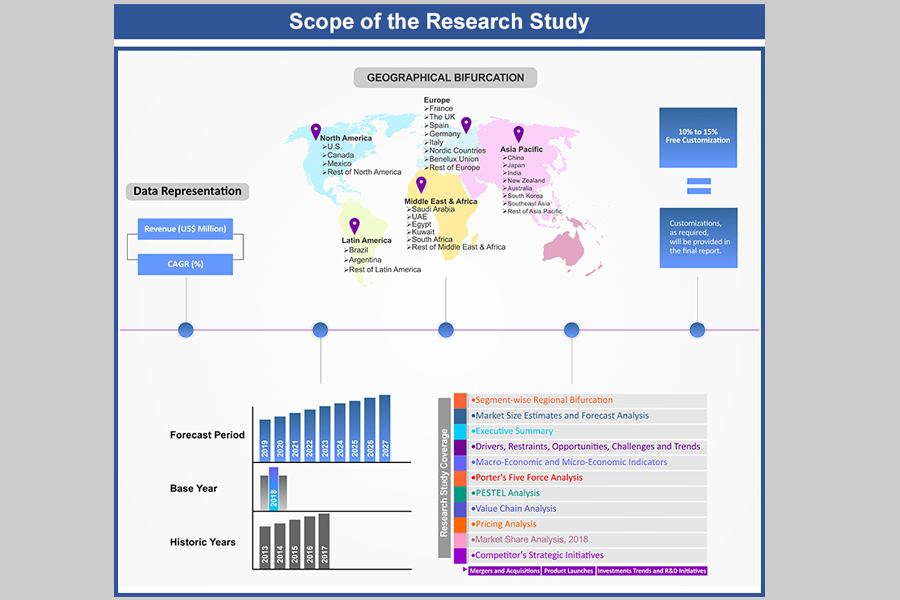
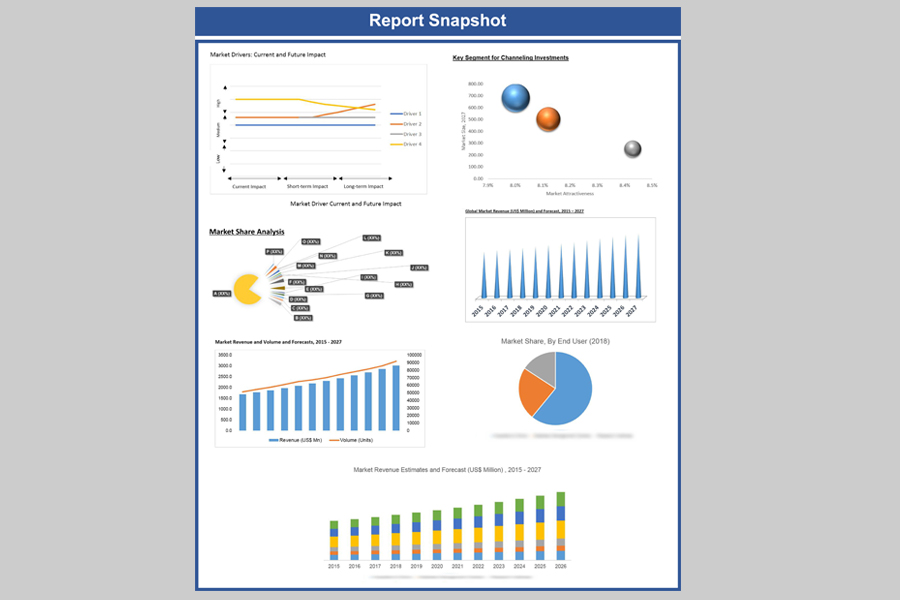
Why Absolute Markets Insights?
An effective strategy is the entity that influences a business to stand out of the crowd. An organization with a phenomenal strategy for success dependably has the edge over the rivals in the market. It offers the organizations a head start in planning their strategy. Absolute Market Insights is the new initiation in the industry that will furnish you with the lead your business needs. Absolute Market Insights is the best destination for your business intelligence and analytical solutions; essentially because our qualitative and quantitative sources of information are competent to give one-stop solutions. We inventively combine qualitative and quantitative research in accurate proportions to have the best report, which not only gives the most recent insights but also assists you to grow.


